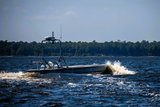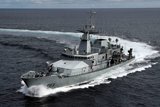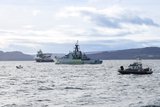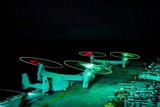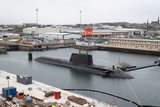Iran’s new warship dismissed as ‘vanity project’
The Iranian Revolutionary Guard Corps Navy (IRGC(N)) announced a new addition to its fleet on 19 November with the unveiling of a large, multirole surface combatant, with claims from state media outlet IRNA that it can host fighters, helicopters, fast boats and ASuW/AAW missile systems.
Officially named Shahid Rudaki, the vessel, dubbed an ‘ocean-going, aircraft carrier warship’ by state media, is 150m in length and 22m at the beam. Released images indicate the Shahid Rudaki could have been derived from a Handysize-type merchant vessel.
The foredeck appears to have four two-cell launch canisters installed, possibly for Noor anti-ship missiles,
Already have an account? Log in
Want to keep reading this article?
More from Naval Warfare
-
![Indo Pacific 2025: Australian Defence Force sets its sights on autonomy]()
Indo Pacific 2025: Australian Defence Force sets its sights on autonomy
Multiple autonomous systems and technologies were on display at this year’s Indo Pacific, but questions remain over how the Australian Department of Defence will balance the books.
-
![How the UK Royal Navy is powering up its hybrid fleet to combat new threats]()
How the UK Royal Navy is powering up its hybrid fleet to combat new threats
Since it announced its move towards a new “hybrid navy” earlier this year, the force has announced a number of new uncrewed technologies in the works.
-
![US and UK to begin Trident II D5 Increment 8 in October 2026]()
US and UK to begin Trident II D5 Increment 8 in October 2026
Trident II D5 Increment 8 will involve improvements to the shipboard navigation subsystem for the US Ohio and Columbia and the UK Dreadnought and Vanguard submarine classes.
-
![What capabilities has the US deployed in the Caribbean and South America to engage “drug boats”?]()
What capabilities has the US deployed in the Caribbean and South America to engage “drug boats”?
The US arsenal includes amphibious assault and littoral combat ships, cutters, destroyers, landing platform docks, a nuclear-powered fast attack submarine, drones, ISR aircraft, helicopters and fighters.
-
![HMS Agamemnon: details of the dive and what the Astute-class signifies for the UK Royal Navy]()
HMS Agamemnon: details of the dive and what the Astute-class signifies for the UK Royal Navy
As HMS Agamemnon moves closer towards joining the UK’s in-service submarine fleet, how does the sixth Astute-class fit into the Royal Navy’s defence strategy?








